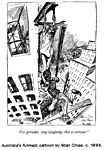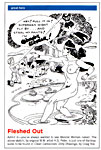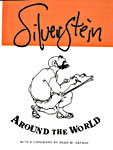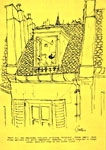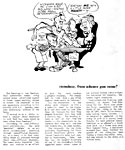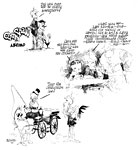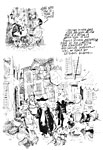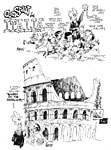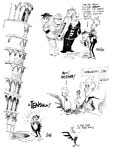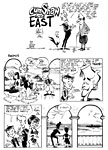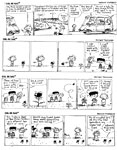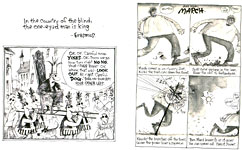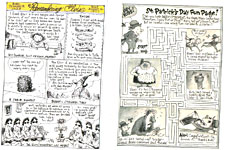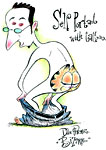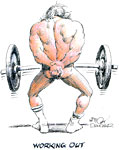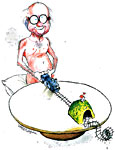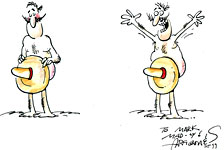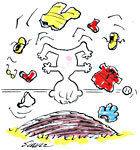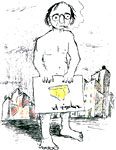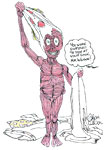 |
|||||||||||||||||||||||
|
NOUS R US
Ahmadinejad and Frank Miller
Muhammad Cartoons Again
Peanuts in Video
La Cucaracha
The Boondocks
Returns to Late Night TV
Aussies Get Ready for the Stanleys
Richard Goldwater Dies
THE FUND FROM FUNKY WINKERBEAN
Raising Money to Fight Cancer
BOOK MARQUEE
Golden Notebook History of AAEC
Stick to Drawing Comics, Monkey Brain
Clean Cartoonists’ Dirty Drawings
Shel Silverstein Around the World
EDITOONERY
Kofi Annan and Cartooning for Peace
The Art of Ill Will Reviewed
COMIC STRIP
WATCH
Sexual Intercourse in the Funnies and with Halle
Berry
Ellie’s Father in FBOFW
Farting in Zits
Bill O’Reilly in Candorville
Richard
Thompson’s Cul de Sac and Richard’s Poor Almanac
FUNNYBOOK FAN
FARE
The Last Fantastic Four Story
Superman/Batman and Bekka’s Bosom
Casanova No. 9, Still a Raving Hoot
Groo at Twenty-five
MARKY’S NUDES
A Gallery of Naked Cartoonists
And our customary reminder: don’t forget to activate
the “Bathroom Button” by clicking on the “print friendly version” so you can
print off a copy of just this lengthy installment for reading later, at your
leisure while enthroned. Without further adieu—
NOUS R US
All the News
That Gives Us Fits
Amid all the excitement aroused in New York a week or
so ago by the antics of Iran’s odd and virtually powerless president, Mahmoud
Ahmadinejad—the city’s denying him the privilege of placing a commemorative
wreath at Ground Zero and the breach of academic etiquette perpetrated by
Columbia’s president, Lee Bollinger, who, despite his bad manners, won our
applause by voicing an opinion that most of us shared and endorsed—few, except
the ever-vigilante New Yorker on
October 8, noticed the history lesson he delivered to Frank Miller at a Ramadan pep rally held for American-Iranians at
the Hilton Hotel in mid-Manhattan. After the ceremonial dinner, Ahmadinejad
ascended to a microphone and expressed his dudgeon at the “insults” the U.S.
had committed on Iran’s notable history. Discussing Miller’s movie “300"
about the Battle of Thermopylae, he said: “That film claimed that under Darius
the Great twenty-seven nations paid tribute to Iran. But in a meeting I was in,
I corrected that impression,” the crusading president coyly announced. “‘No,’ I
said, “under Darius forty-two nations paid tribute to Iran!’” Take that, Frank!
That’ll teach you to say anything about Iran. Well, you live and learn. Every
day in every way, we get better and better.
A
Danish cartoonist is making trouble again. Animator Anders Morgenthaler has
produced “a manga-style animated revenge fairy tale” about a vigilante
clergyman who avenges the death of his porn star sister. Oliver Duff at the London Independent reports that “the
film depicts explicit intercourse, sexual abuse, drug taking and bloody
violence and was censored at the Singapore Film Festival because it was
considered religiously offensive. Censors objected to a scene which depicts ‘a
porn star in a nun’s habit with a cross protruding from her behind,” Duff
concludes, adding that British expletive that so perfectly summarizes outrage
and alarm, “Crikey!” Morgenthaler maintains that the film is an attack on the
porn industry, which, he said, “has encroached into our society and culture to
such a degree that I think we have to speak up against it.” We’ll see, now,
whether this Danish artifact will inspire riots in the streets and flag
burnings by devout “men of the cloth” and their adherents. Not likely, not in
the secular West.
The
Swedish artist who insulted Islam in August by putting Muhammad’s face on what
he says is a dog’s body claims he is not afraid despite death threats and the
$10,000 bounty offered by al Qaida in Iraq to anyone who kills him. But he
admits that he looks under his car for a bomb every day before he starts the
vehicle. Lars Vilks, who maintains
that he drew the Muhammad dog as a way of testing the boundaries of artistic
freedom, is now contemplating ways of capitalizing on the uproar over his
drawing. “The Muhammad cartoon must be made into an art work,” he told Karl
Ritter of the Associated Press, “—a musical comes to mind. I think it would
help the debate.” Despite the threats, Vilks said: “Most Muslims are, of
course, just like other people. They are friendly and nice. Even if they are
insulted, they still behave civilized.” Muslims living in the West must become
accustomed to disrespectful drawings, he continued, “because here in the West
we mock everything. Muslims will understand that this is the system we have and
it’s not really against Muslims; it’s just the principle of being able to
insult religions.”
Meanwhile,
reports Stephanie March on abc.net.au, in Indonesia a new comic book series, The 99, has been launched featuring
superheroes each of whom bears one of Allah’s 99 names. Intended to appeal to
young Muslims who, increasingly, enjoy Western-style media, the comic book will
not “preach to kids about how to be more religious,” its publisher claims, but
will reflect “the universal values that Islam has,” bringing them “into
society,” which, he continued, is a “good thing, whether it is in pop culture
or in any other form.” Now available in eight Middle Eastern countries, The 99, despite its initial setting in
13th century Baghdad, is a metaphor, says its creator Naif Mutawa, for “what is happening in
the Islamic world” today.
From Editor & Publisher: The Sandbox: Dispatches from Troops in Iraq
and Afghanistan (336 6x9-inch pages; paperback, $16.95) collects 90 posts
to the military blog The Sandbox, created a year ago by Garry Trudeau at his Doonesbury.com site. In their posts, soldiers
write about military life in those far-flung corners; description, not
political doctrine, is the mode. Lightly edited by David Stanford of
Doonesbury.com and GoComics (who also edits Rants & Raves into bite-size
bits for that site), the dispatches are thoughtful and sometimes
heart-wrenching. The soldiers who compose them are clearly writers or would-be
writers. And the blog marches on at Doonesbury.com. ... Peanuts tv specials, more than 50 of them on the shelves, will be
remastered with new bonus features for the home market by Warner Home Video,
which also plans to created direct-to-video features with the Peanuts
characters, plus “short original programming for digital distribution via
wireless and other platforms.” Before long, in other words, there’ll be Peanuts
videos produced without the guiding hand of the characters’ creator, Charles M. Schulz, something I had
thought was eschewed by those in control of the Schulz estate. Could be I’m
remembering wrong. Jean Schulz, widow of the cartoonist, said: “After meeting
the Warner creating team, it’s clear that they have an understanding of and
dedication to classic animation, which we think will make them a great
distribution home for ‘Peanuts.’” Other partners in the deal are Schulz
Creative Associates and Lee Mendelson Film Productions, a thoroughly
respectable lash-up. ... For Fashion Week in New York last month, top
designers, such as Betsey Johnson and Isaac Mizrahi, created frocks inspired by
Peanuts characters for the runway show “Snoopy in Fashion.”
Also
from E&P: The Houston Chronicle has removed Lalo Alcaraz’s La Cucaracha from its print line-up,
retaining the strip only in its online edition. Taking its place in print is Arctic Circle, a strip about three
penguins who migrate to the northern ice cap, by Alex Hallett, a New Zealander, about as far removed from Texas
pertinence as possible. Wrote one reader: “You replaced a comic with biting
commentary on the political and social scene with a strip about penguins? I’m
disappointed beyond words.” Alcaraz, in concert with the League of United Latin
American Citizens (which sounds, suspiciously, like an organization Alcaraz
invented for the occasion), has encouraged fans to lobby the paper to get the
strip back in print. James Campbell, the paper’s “readers’ representative,”
said that the strip’s political slant was not the issue; “objectionable content
was. Editors often had to call the syndicate editor and request that the strip
be modified or that a substitute be sent because the strip’s language was
offensive to some readers generally” but especially to Latinos. Not swear words
or obscenities, just racially or culturally loaded terms. La Cucaracha, like Aaron
McGruder’s The Boondocks, features a racial minority cast which ridicules its minority as often as it
assaults the majority for racist attitudes or for absurd unthinking devotion to
faddish pop culture.
McGruder,
meanwhile, is back, attacking current events, rappers, race relations and the
state of black popular culture. But only on tv. The second season of the
animated version of The Boondocks debuted October 8 in the Cartoon Network’s edgy
late-night “Adult Swim.” The delay between seasons was due, McGruder told Roger
Catlin at the Hartford Courant, to
the cartoonist’s desire to “get the animation right.” He wasn’t happy with the
first season’s product. But he’s more than happy with this year’s production,
according to Greg Braxton at the Los
Angeles Times, who witnessed McGruder’s “busting up” laughing, “bobbing and
weaving,” as he watched a new episode in which the show’s most unsavory
character, Uncle Ruckus, “a foul-mouthed black man who hates black people,”
reappears. McGruder’s memories of the show’s first season are not pleasant.
“There’s only one word for that first season,” he told Braxton, “—insanity. It
was just a horrible situation. I hadn’t worked one day of tv in my life, and
all of a sudden, I’m running my own show. I didn’t know, when you work on an
animated show that there’s a crisis every week. Only the first year work on the
comic strip alone was harder.”
To
realize his lifelong dream of having his own tv show, McGruder had to leave his
daily comic strip, which was, in many ways, the perfect platform for a
satirist: he could comment on topics in the news while they were in the news.
With an animated cartoon, the production time often consumes a year. For a
short while, McGruder tried to do both the animated show and the daily comic
strip; but he couldn’t—“it took a huge toll on me,” he said. He’s happier now,
focused on just the animated version. And this year, it’s a better-looking
show, McGruder believes: “It looks so much better, the performances are better,
everything is just coming together. It’s just so much more satisfying, and
we’re much closer to the goal of what I think the show can be.”
The
show won a Peabody in its first season for “The Return of the King,” an episode
in which Martin Luther King Jr. awakens from a 32-year coma and, after
witnessing bling-wearing rappers and raunchy images on BET (Black Entertainment
Television), abandons his “turn the other cheek” code. Even if McGruder can’t
ridicule some topics because they are too short-lived, other topics fade and
then return. “It’s amazing,” McGruder told Catlin, “how we write these things,
and then take a year and a half to make them, and as they’re coming out, they
become relevant again. We wrote this episode called ‘The N Word’ and, after we
wrote it, the Michael Richards thing happened. Then the Don Imus thing
happened. And we didn’t have to change a thing.” His regular use of the N–word
on the show inspired no little complaint from the likes of Al Sharpton and
other black activists. McGruder explained, then, that “it feels fake to write
about it and to avoid using it.” Now, he takes a somewhat different approach to
explanation: “I cannot in any way defend what I do,” he said; “I use the word
in the show because I’m a bad person.”
A
new website being ginned up by comic book collector Andrew Filipowski will
offer fellow collectors a place to catalog their collections online “for either
bragging rights or insurance purposes,” according to bizjournals.com, or, if
the price is right, for purchase. Filipowski’s sponsoring company, Rakote.com,
will earn a small fee for facilitating such transactions.
During
a panel discussion on superheroes held during the annual New Yorker Festival
October 6, Tim Kring, creator and
head writer for the hit tv series “Heroes,” said what yielded, for him, the
most drama in the superhero persona was “treating superpowers as an affliction:
how do you have a job, pay the rent or have a relationship when you have these
powers?” The panelists, who, in addition to Kring, included novelist Jonathan Lethem (The Fortress of Solitude) now writing Omega the Unknown for Marvel, artist-writer Mike Mignola (Hellboy), and Grant Morrison, who has been
working regularly in superhero comics for some years now, were asked to explain
the appeal of superheroes, reported Peter Sanderson in PW Comics Week. Kring said “Heroes” reflects a post-9/11
sensibility, the wish fulfillment of the ordinary person to do something in a
world that seems to be going to hell. I suspect, however, that superpowered
beings appeal to us for reasons buried far deeper in the human psyche—or maybe
not so deep—in the simple desire to surmount the physical limitations that
restrain us from achieving our desires. In effect, they represent our
frustration with being human. A member of the audience, concerned about the
future of funnybooks, asked if superhero movies and tv shows stimulated comic
book sales. Most of the panelists expressed doubt. Mignola worried that people
who came from Hellboy movies to the comic book would be disappointed because
they couldn’t recognize in the print medium what they’d seen in the movie.
Lethem, considering the presence of superheroes in so many entertainment media
today, contended that it is highly unlikely that a young reader would encounter
any of the longjohn legions first in a comic book. Morrison said it was more
likely that a movie-goer would buy a Spider-Man towel than a Spider-Man comic
book.
Down-under
’tooners, which is what we’re calling members of the Australian Cartoonists’
Association (people who know where to put an apostrophe, something their
American counterpart, the National Cartoonists Society, hasn’t yet figured
out), will hold the 23rd annual Stanley Awards Conference November
2-4 in Wollongong NSW. Their Stanley is the Aussie equivalent of the NCS
Reuben, the “cartoonist of the year” award, and it’s named after the legendary Stan Cross, who made comic strip
history in Australia with a strip called You
& Me, and sometimes Me & You, which he launched in August 7, 1920 and continued until Christmas Eve in 1939,
when he left his strip’s host newspaper for another. John Ryan in his history
of Australian comics, Panel by Panel, wrote: “In terms of drinking, arguing, swearing and displays of bad temper, You & Me remains unique in
Australian comic history and pre-dated many aspects of the anti-social Andy Capp by almost 40 years.” Jim Russell took over You & Me when Cross left, re-naming
it Mr. & Mrs. Potts and toning it
down somewhat; he continued to produce it for the next sixty years or so,
making it the longest running strip in Australian history. Cross did several
other strips until he retired in 1970 at the age of 82; he died June 16, 1977.
Apart from creating You & Me, Cross
was noted for single-panel cartoons, one in particular is celebrated as the
country’s funniest cartoon. Known by its caption—“For gorsake, stop
laughing—this is serious!”— it was initially published July 29, 1933; it caused
so much excitement that, two weeks later, the newspaper reprinted it on glossy
paper and sold it for two shillings, six pence, an unprecedented maneuver. Richard H. Goldwater, 71,
president/co-publisher of Archie Comics, died October 2 after a long battle
with cancer. The company was founded by his father, John Goldwater, with two business partners, Louis Silberkleit and
Maurice Coyne. Richard joined the operation after graduating from college in
about 1958. According to an Archie press release, Richard worked his way up in
the company, “learning all facets of running a successful comic book publishing
business.” (Archie Comics, inspired by the fabrications of John Goldwater,
often uttered truths not apparent to researchers and historians; for more in
this vein, visit Harv’s Hindsights, where, in the summer of 2001, we
posted a biography that refuted John’s claim to have invented Archie and the
Riverdale gang.) Eventually, as editor-in-chief, Richard strived to continue
producing “good, clean, wholesome comics suitable for family entertainment.”
The wardrobes of Archie characters have changed over the years, but the
youthful stars stayed virtually the same, and their so-called adventures never
reflected any troubling aspect of teenage life in America. No drugs, no sex, no
swearing. For a long time, Archie Comics successfully suppressed a Harvey
Kurtzman satire of Playboy because it
used caricatures of the Archie characters. And the company prevented Dan DeCarlo, who perfected the “Archie
style” of drawing, from profiting from his creation of Josie and the Pussycats.
LISA’S FUND
University Hospitals Ireland Cancer Center in
Cleveland has unveiled a new fund raising campaign, Lisa’s Legacy Fund for
Cancer Research and Education, named in honor of the character who died October
4 in Tom Batiuk’s comic strip, Funky Winkerbean. All money donated to
the Lisa’s Fund will go to cancer research and education, including all of
Batiuk’s royalties from the book, Lisa’s
Story: The Other Shoe (reviewed in Opus 211). Batiuk, himself a cancer
survivor, devised his Lisa storyline deliberately, thoughtfully, and is not
surprised by some negative reaction from readers who say the comics are no
place for death and disease. Quoting an August post on www.thecancerblog.com, Jesse Leavenworth of the Courant, said it echoes many who object to the strip's storyline.
The
post, from Millie Mussomeli, was addressed to Batiuk and said in part: "I just can't stand the storyline
about Lisa dying with cancer. I believe
there is so much tragedy in this world and that sadness has affected every
person's life. Comics are supposed to be interesting, funny, and relieve some sadness. They used to
be called the ‘funnies’ in the old days,
because that is what the family looked forward to seeing every day. ... Believe
me I am REALLY upset by your storyline. Lisa has a small child. I know this
happens in real life, but why don't you write a book or do a movie instead of creating such sadness in the `funnies'?"
Batiuk
said he understands his critics. "They feel I'm violating some rule of
cartooning. ... They feel I owe them a funny cartoon every day," Batiuk
told The State newspaper in Columbia, S.C., last month. "What I owe
them is the best work I can do every day."
"Lisa
is a magical character. As a writer, you hope to create characters that will
connect with people," Batiuk said in a prepared statement accompanying the
press release on Lisa's Legacy Fund. "Lisa connected with readers—and took
me through some of the most difficult situations in the strip. Lisa opened
doors for me and allowed me to challenge myself and take my work to a new
place. I wanted Lisa's story to be both an inspirational tale and a cautionary
one—to remind people to be checked for cancer," said Batiuk. "Through
Lisa's Legacy Fund, Lisa will be doing
real-world good in the fight against cancer. It is a real honor as a
storyteller."
Fascinating Footnote. Much of the news retailed
in this segment is culled from articles eventually indexed at http://www.rpi.edu/~bulloj/comxbib.html,
the Comics Research Bibliography, maintained by Michael Rhode and John Bullough, which covers comic books, comic
strips, animation, caricature, cartoons, bandes
dessinees and related topics. It also provides links to numerous other
sites that delve deeply into cartooning topics. Three other sites laden with
cartooning news and lore are Mark Evanier’s www.povonline.com,
Alan Gardner’s www.DailyCartoonist.com, and Tom Spurgeon’s www.comicsreporter.com. And then there’s Mike Rhode’s ComicsDC
blog, http://www.comicsdc.blogspot.com
BOOK MARQUEE
The 50-year history of the Association of American
Editorial Cartoonists is carefully reconstructed in The Golden Notebook, a special 112-page edition of the AAEC
newsletter. Intended for the edification and amusement of AAEC members, most of
whom weren’t around when the organization was founded in 1957, this invaluable
historical document is now being offered for sale to all comers at the AAEC
website, http://editorialcartoonists.com, for a mere $20. Many
of the pages are devoted to reprinting portions of the 25th anniversary publication, but the up-dating includes much more than merely
adding the convention reports since 1982. V.
Cullum Rogers, the AAEC secretary-treasurer for life, cartoonist for The Independent Weekly of Durham, NC,
and passionate historian of the medium, spent much of the past year pawing
through the organization’s archives at Ohio State University’s Cartoon Research
Library and thumbing the pages of Editor
& Publisher at Duke University to assemble a timeline of notable events
in editorial cartooning in the U.S. and abroad since 1957. Details about the
founding of AAEC, which infected my report in Opus 208 and in The Comics Journal No. 285 on the AAEC
Convention in Washington, D.C., come almost entirely from The Golden Notebook. Highly recommended.
Stick to Drawing Comics, Monkey Brain,
is the title of a new book by Dilbert’s creator, Scott Adams, who collects between
its covers some 150 short essays, “often humorous” according to Editor & Publisher, on “such topics
as politics, religion, marriage, dancing, underwear, aliens and why kangaroos
don’t drive cars,” culled, mostly, from Adams’ blog. ... Donna Barr, whose engaging comedic and satiric charm has been, for
years, on display in comic books about a gay Nazi officer (The Desert Peach), centaurs (Stinz), German culture and the influence of the military on society, has mustered all
of her characters in a single title, Afterdead,
launched in August, or thereabouts. “In Afterdead,” writes Kate Culkin at
Publishers Weekly Comics Week, “Barr creates a futuristic, militaristic
afterworld run by the Reich, which is inhabited by many of her existing
characters. Pfirsich Rommel (the gay brother of the famed Desert Fox) is an
Afterdead and his brother is a terrorist known as the Raider. Stinz is a
disgruntled officer in the Reich and his wife Bruna is his sergeant.” Published
by Barr’s imprint, Fine Line Press, the book is available through online
retailers, lulu.com, and Barr’s website. I couldn’t find her website, but I
found Afterdead at lulu.com.
November’s Playboy includes the accompanying
drawing of a naked Wonder Woman, ostensibly rendered by the character’s
original artist, H.G. Peter. The
drawing, as the text beneath the picture reports, is “just one of the treasures
to be found in Clean Cartoonists’ Dirty
Drawings, a new anthology by Craig Yoe.” By
May 1957 when Shel Silverstein began
a mock travelogue series for Playboy with cartoons about his return to Tokyo, the scene of his earlier triumph while
cartooning, as a G.I., for the Pacific Stars
and Stripes, I was just finishing my sophomore year in college, and I
knew—as every young cartoonist must’ve known immediately upon seeing
Silverstein’s Tokyo ’toons—that “this” was what I wanted to do. I wanted to
travel the globe, expenses paid, drawing cartoons about my adventures, which,
with Silverstein as inspiration, was certain to include a verifiable quantity
of amorous encounters with toothsome cuties in suitable dishabille. As you may
have noticed, I didn’t make it. As I’ve said elsewhere (here, in
Hindsight, with an appreciation of Silverstein written after his death in
1999), I scarcely had the talent to be another Shel Silverstein. And I’m about
to provide irrefutable proof, anon.
All of Silverstein’s travel ’toons have, at last, been collected in a single volume, Playboy’s Shel Silverstein Around the World (190-some 8x11-inch pages in hardback; Fireside, $24)—Shel in foreign capitals, Tokyo, London, Paris, Moscow, Hollywood; in foreign climes, Italy, Switzerland, Spain (where he fights a bull), Greenwich Village; in peculiar locales, among the Arabs, in a nudist camp, on Fire Island, among the hippies. When Hugh Hefner, Mr. Playboy, sought to capitalize on Silverstein’s return to Tokyo by getting the cartoonist to send back to the magazine cartoon reportage of his adventures, Silverstein “agonized” about it, he said: “I couldn’t see what I would draw about that would be good for Playboy. I never wanted to do the sexy stuff. I wasn’t going to do that there. I didn’t think they’d want general gags or subtle stuff. I didn’t want to draw about myself.” But all of that was exactly what he did—some sexy stuff, general gags and subtle stuff, and pictures of himself. He was Everyman—or, rather, the typical American young stud whose understanding of the world beyond Chicago’s State Street was festooned with stereotypical vision and provincial prejudice. And so in Paris, where he’s being taken into custody by a gendarme, Silverstein has himself saying: “You let Gene Kelly dance in the street, you let Fred Astaire dance in the street, you let Audrey Hepburn dance in the street, you let —.” In Italy, he stands before an elaborate rendering of the ruined Colosseum and says to the guard, “Show over?” In Moscow, he looks at a roulette wheel spinning around and murmurs, “What’s so dangerous about this—?” Subtle, like he says. And just a soupcon of sexy stuff. In Greenwich Village, he depicts himself standing on Bleecker Street being harangued by a girlfriend, who says: “They’re talking about us all over the Village—down at the Figaro, over at Whalen’s, down at Joe’s, up at the Bagel—they’re all saying we’re not sleeping together. Now maybe you don’t give a damn what people think, but I do!” In Scandinavia, home of the pneumatic Anita Ekberg (this was in July 1957 when she represented a glorious Scandinavian pneumaticism), Silverstein draws himself sitting next to a spectacularly flat-chested wench, who says: “Well, my goodness—are all American girls built like Jayne Mansfield? Are all Italian girls built like Sophia Loren? Are all—.”
The
cartoons are reproduced exactly from the pages in the magazine where they first
appeared, including the blocks of overprinting color, art director Art Paul’s
idea: he thought the magazine needed color, and pages of Silverstein’s
black-and-white cartoons would be visually monotonous, he thought. But the
overprinting gave the cartoonist’s nuanced art a garish glaze; the color blocks
were a mistake, and even Paul admits it in the book’s Introduction by Mitch
Meyers, who, in his pages, regales us with anecdotes about Silverstein’s
travels as well as a short biography and some insight into how Silverstein fit
into the Playboy mystique: “A
perpetual houseguest at the Playboy Mansion [in Chicago, the magazine’s
birthplace], Shel began painting and drawing (and traveling) with LeRoy Neiman.
He also became friendly with two young comics, Lenny Bruce and Bill Cosby. He
spent a lot of time at Chicago clubs like the Gate of Horn and was tight with
folksinger Bob Gibson. Maintaining an apartment in Manhattan, Shel hung out
with radio great Jean Shepherd and playwright Herb Gardner.” The Introduction
and the reprinted pages are lavishly emblazoned with photos of Silverstein
wandering the environs of his destinations, often accompanied by lithe
representatives of the opposing sex. Silverstein’s method was to spend days,
even weeks, hanging around, watching, sinking into the local ambiance. Larry
Moyer, a friend and photographer who accompanied the cartoonist on several
trips, said the plan was pretty straightforward: “We were looking for bad girls
and good food. That was the bottom line.”
According
to Steve Duin at blog.oregonlive.com, Silverstein’s dispatches from the edges
of the world came in bundles of cartoons and photographs, “often accompanied by
a letter, ‘scrawled on a gigantic page of his sketch pad.’” From San Francisco,
Silverstein wrote: “I tell myself I’ll start drawing today and head down Haight
Street toward Hippie Hill. Three people sit in a doorway smoking grass. A guy
in a monk’s robe asks me for some spare change. Electric rock comes from a
basement window. The girls line up at the free clinic to get their
birth-control pills—a sign says Don’t Give the Clap to Someone You Love. The
tourists drive by with their windows rolled up. ‘Wanna buy a lid?’ The Diggers
ladle out free beef stew and apples. Beads, pot pipes, posters, underground
newspapers for sale. Written on a psychedelic-painted truck, Don’t Laugh, Your
Daughter May Be in Here! A hand reaches out of some bushes and gives me a
roach. A long-haired girl takes my hand and leads me up a path through some
trees, where we lie down. Afterward, she smiles and says, ‘Welcome to
Haight-Ashbury.’ I think I’ll wait and draw tomorrow.”
A
retrospective like this one yields insight into an artist’s development as an
artist. By the end of the book—by 1968, eleven years after the series
started—Silverstein’s drawing style was much the same in a general way, but his
lines, although still languid, looping easily through their motions, were often
firmer, even bold, and the pictures were sometimes embellished with more
elaborately realized decorative detail. And, a final visual bonus, here’s a
drawing of Silverstein by Hefner, a frustrated cartoonist himself, dated April
28, 1966.
In
our Hindsight department for April 2001, I have written about Silverstein at
much greater length, elaborating on an obit I wrote shortly after he died. This
essay I converted to a monograph in 2004, and, by way of celebrating Playboy’s 50th anniversary, I
added 23 pages of Silverstein cartoons that, to the best of my knowledge, have
never been reprinted anywhere—namely, his History of Playboy, recorded in
cartoons featuring barenekidwimin, eager photographers, and caricatures of the
perpetually pipe-smoking Hefner, all lifted from the first three 1964 issues of
the magazine. One of these artifacts can be yours for a mere $8 (including
p&h); write me at the link at the end of this diatribe for payment details
and other whatnots.
And now, by way of proving, beyond all reasonable demurer, that I could not, ever, have been Shel Silverstein, here, in a trice, we have the evidence, namely, my attempts at being Shel Silverstein. As I reminded you earlier, I didn’t make it into Playboy with my version of Silverstein’s cartoon travelogue, but I did manage to get an expense-paid trip half-way around the globe—to the Mediterranean Sea, courtesy of the U.S. Navy. Bounding over the heaving main, or vice versa, I did cartoons for the ship’s monthly magazine—no Playboy, and no lewd lovelies in sight but a chance, nonetheless, to do a low budget blatant imitation of Silverstein, starring my shipboard cartoon character, Cumshaw, a beaky enlisted man whose cunning evasion of all forms of work lent cartoon reality to the nautical meaning of his name: “cumshaw, (verb) to obtain material through unapproved channels or (noun) the material so obtained.” Herewith, a sample.
See
also Editoonery, below, where we
review, briefly, the latest history of political cartooning in America.
ONWARD, THE
SPREADING PUNDITRY
The Great Ebb
and Flow of Things
In the last analysis, the Bush League convicted Jose
Padilla, a 36-year-old American citizen born in Brooklyn who converted to
Islam—the so-called “dirty bomber”—of “conspiracy to murder, kidnap and maim
people in a foreign country” and “material support” for Islamic terrorism
because he allegedly filled out an application form to attend training at an Al
Qaeda camp. That was the proof, the evidence, the “beyond a reasonable doubt.”
The prosecution was unable to prove that Padilla actually joined Al Qaeda, or
that he even went to one of those Afghanistan camps. Ted Rall, who draws acerbic cartoons and writes an insightful
column, treats this subject at some length in his column for August 21; visit www.tedrall.com for details (click on “Columns” then “Headline
Archive” at the upper right, then find “It Did Happen Here”).
No
one can possibly be surprised that Blackwater, a private army of security
guards, is brutally aggressive in the performance of its assignment in Iraq and
that various of its rank and file have, in pursuit of what they conceive to be
their duty, killed innocent bystanders, by the dozens. The people who sign up
to be Blackwater operatives are not the sort you’d invite to your grandmother’s
house for tea. They’re professional tough guys. They like warfare, shooting
guns, and killing and maiming people. Not all of them, but a lot of them. Some
of them—perhaps most of them—are motivated by sincere patriotic beliefs. But
they’re still professional tough guys, not barflies or folksingers. They like
violence. Why else would they sign up to work as gunslingers? Most of them have
arms as big around as Barry Bonds’. Most of them are as clean-cut looking as
the company’s founder, Erik Prince, whose well-groomed fraternity boy
appearance belies the blood-thirstiness of his company’s methods. So what
should we expect when we hire such devotees of physical force and throw them
into a hostile environment that bristles with unanticipated menace at every
street corner? Blackwater’s operational solution to this dilemma is “shock and
awe.” Careening in black SUVs through Baghdad at high speeds, forcing other
vehicles off the streets, all the while brandishing high-powered weapons and
occasionally firing them at random, Blackwater teams behave at all times in a
belligerent and intimidating manner, hoping to forestall roadside ambushes by
scaring the enemy away. It’s a terrorist tactic applied in a terrorism
environment, and, judging from one kind of result—none of the U.S. diplomats
being protected by Blackwater have been killed or seriously harmed—it works.
But Blackwater’s techniques are giving America a bad rap: Iraqis don’t
distinguish the good soldiers from the armed-to-the-teeth “security” cowboys. They’re
all Americans, and the cowboys mistreat Iraqis enough to seriously impair our
efforts to win hearts and minds. Moreover, the reliance on mercenaries to
perform duties that historically have belonged to the miliary undermines the
military. Blackwater and other similar security companies in Iraq recruit from
the ranks of former Navy Seals and other elite fighting forces. And Blackwater
operatives are paid much better than soldiers in the U.S. Army. The prospect is
that the military will begin to suffer a “brawn drain” as trained and
experienced special forces personnel decline to re-enlist in favor of joining
the better paid ranks of Blackwater and its ilk. Blackwater employees can make
two or three times the money their equivalents in the armed forces make.
General David Petraeus earns roughly $493 a day; a senior manager in Blackwater
makes $1,075 a day.
EDITOONERY
Afflicting
the Comfortable and Comforting the Afflicted
Former UN Secretary General Kofi Annan is
responsible, with editoonist Jean Plantu of France’s Le Monde, for the
formation of Cartooning for Peace—a meeting, or a conference, or an exhibition,
all of the above—intended to foster the “unlearning of intolerance.” Although
the casual chronicler might think Annan was inspired by the disturbance caused
last year by the Danish Dozen, that isn’t the case, says Brigid Grauman of the Financial Times: “Annan was shocked that
Arab cartoonists used anti-Semitic Nazi imagery to depict Israelis, and that
Israelis mostly drew Arabs as suicide bombers.” Annan then asked Plantu if he
could assemble a conference and exhibition at UN Headquarters to combat
intolerance. The first event took place early in 2006 and posed both the name
of the project and its challenge: "Cartooning for Peace: The responsibility
of political cartoonists?" The Associated Press last year reported that
Annan said in opening remarks that cartoons "can encourage us to look
critically at ourselves, and increase our empathy for the sufferings and
frustration of others, but,” he continued, “they can also do the opposite. They
have, in short, a big responsibility."
During
the initial seminar, the AP account went on, the cartoonists exhibited their
work and discussed the power of the medium that incorporates humor, irony and
politics, which sometimes results in a volatile mix. Many of the cartoonists
said their work must not be created primarily to incite tensions that could
result in violence, while others acknowledged they cannot always determine when
they will cross the line. But they all agreed they must pay attention to the
present political climate of the world. "We have a job to be more
sensitive," said Plantu."It is a new challenge for us," he told
reporters at a press conference during a break in the day-long session.
One
of the 40 Danish cartoonists originally contacted to depict the Prophet
Muhammad in the fall of 2005 was Carsten
Graabaek, who accepted Plantu’s invitation to speak at the UN in early 2006
"with some trepidation,” the AP reported. Unlike the 12 cartoonists who accepted
the invitation from the Jyllands-Posten newspaper, Graabaek said he declined to render a drawing because he
"hadn't any squabble" with the Prophet. "I think cartooning is
about what goes on Earth and freedom of speech is a worldly affair, a secular
affair, whereas the Prophet and respect for the Prophet and the ban on drawing
or painting his likeness is a spiritual matter," Graabaek said. He said
the two should remain separate. "Instead of having these endless
discussions that are still going on, I think we should scrap the whole
argument, because it leads nowhere," Graabaek concluded, adding that
cartoonists should be politically correct, despite the stigma the term carries.
While
Plantu called for more sensitivity by cartoonists, according to the AP, he was
joined by others who disagreed with codifying what subjects should be avoided.
"It's not our job to say what should be drawn and what should not be
drawn," he said. As we reported here in Rancid Raves last year, Mike Luckovich, a U.S. editorial
cartoonist for the Atlanta Journal
Constitution, said cartoonists should not have to follow political
correctness, but should question their own motivations. "I don't think you
should incite people, just to incite them," he said. "And I think
that's what the Danish cartoonists, or editors, did."
Annan
said he hoped "we can avoid getting into a kind of 'cartoon war,' in which
one group seeks to retaliate for the offense it has suffered, or believes it
has suffered, by publishing whatever it thinks will be most offensive to
another group."
The
initial gathering of editoonists at the UN in New York was followed by similar
events in Geneva in March and in Paris in April, then Brussels in May this
year. Cartoonists who attend discuss how to avoid offending the sensibilities
of newspaper readers with seemingly bigoted stereotypical imagery while, at the
same time, exercising their freedom to criticize governmental shenanigans and
social foibles. At the most recent meeting, Danish cartoonist Lars-Ole Nejstgaard said: “Our duty is
to attack the government in power.” But how an editoonist fulfills this mission
varies greatly from one culture to another. Thembo Kash cartoons in the Congo where, he said, cartoonists play
“an essential role in explaining to a widely uneducated [illerate, I think he
means] population news that is written in dense, often incomprehensible
language,” reported Grauman in her Financial
Times article.
“Unlike
the French cartoonists, who steer clear of politician’s private lives, Jeff Danziger in the U.S. thinks
they’re fair game,” Grauman continued, quoting Danziger: “their private lives
are a rich source of material, certainly if they don’t practice what they
preach or if they say something odd or interesting—like when Hillary Clinton
said that [her husband] was a ‘hard dog to keep on the porch.’”
I’ve
cobbled up this whole item mostly to get to that quote, which is a beaut, both
in figure and in fact. Danziger, who
just returned from one of the group’s meetings in France, told me that he
thinks the meetings are “okay—but Lord knows what people get out of them. The
one in France,” he continued, “got damn little from me cuz I spoke in English.”
The next meeting is in Atlanta at Emory University, November 10-16.
Book
Review. The Art of Ill Will, a aptly singeing title, purports to be “The Story of American Political
Cartoons” (264 9x9-inch pages; hardback, NYU Press, about $30), and it is that,
but it is more of a genial bus tour than a boots-on-the ground expedition. Its
author, Donald Dewey, begins with admirable acumen: “Editorial cartoons honed
their political blades on technologies, opportunities, and pressures of the
nineteenth century mass media. Had nothing of the kind existed before? Of
course it had,” he concludes, at once dispatching as inconsequential the usual
historian’s preoccupation with who was first. Citing the Egyptians cited by
Stephen Hess and Milton Kaplan in The
Ungentlemanly Art, Dewey goes on: “There are limits to citing such
precedents. Intriguing as they might be, for example, the contentions about
[Egyptian tomb paintings] resemble the enchanted history that has claimed the
sands around the pyramids as the first primitive baseball diamond and
Babylonians as the first vaudeville comics: research dreaming after relevance.”
The book is worth acquiring if for no other reason than to have that last
phrase handy. But Dewey’s casual if not disparaging attitude about history
infects the rest of the proceedings. He notes the importance of the advent of
lithography in advancing the influence of editorial cartoons by making them
more readily available through mass media. And then he says: “Appropriately
enough, the revolutionary surface printing method, which allowed for more
detailed reproductions in a fraction of the time required previously, was
effectively based on the mutual antagonism of oil and water.” Another tidy turn
of phrase—“the mutual antagonism of oil and water”—but how lithography works or
why it is less time-consuming than some previous method of printing images
Dewey neglects entirely to tell us.
In
assaying the arrival of the newspaper editorial cartoon, he contends that “it
wasn’t until 1867 that a significant publisher, James Gordon Bennett, Jr., of
the New York Evening Telegram, printed editorial cartoons on a regular basis.” How regular? How often? Dunno:
Dewey doesn’t say. What’s more, I have a vague recollection that another New
York paper started publishing political cartoons some years before—albeit only
once a week. Dewey also appears to give advertisers an influential role in
dictating editorial attitudes much earlier than I would suppose, given that
advertisers were not numerous in the early years of American newspaper
journalism. Moreover, the earliest successful newspapers were essentially the house
organs of political parties; politicians, not advertisers, would dictate
content. Elsewhere in the same 73-page Introduction (nearly a third of the
book), Dewey says Thomas Nast’s “satirical imagination was processed by razor blades.” Dunno what that is
intended to mean. Did Nast, literally, use razor blades to draw or to embellish
his drawings? Maybe. Or is this a figure of speech about Nast’s nasty
disposition? Can’t say.
Like
others who have gone down this path before, Dewey assumes that Walt McDougall’s famous cartoon
depicting the influence of monied interests on 1884 Presidential candidate
James C. Blaine, “The Royal Feast of Belshazzar Blaine and the Money Kings” was
the cartoon that inaugurated a daily front-page political cartoon in the New York World, setting a fashion that
established the editoon in daily newspapers. This cartoon, Dewey contends, was
rejected earlier in the day by the humor magazine Puck. As McDougall tells the story in his autobiography, he had
picked up his rejected cartoon at the Puck office but, since he was on the way to watch a baseball game, he didn’t
relish carrying the thing around with him. By chance, he was, at about this
moment, passing the premises of the World, and on a whim, he turned into the building, thinking he’d submit the cartoon to
the newspaper. At the last minute, however, he lost his nerve and thrust the
cartoon into the hands of an elevator operator, telling him to give it to the
editor to print if he wanted, free. McDougall then went off to the baseball
game, thinking no more about his cartoon until he saw it on the front page of
the World the next day. But the
cartoon in question was not, according to Charles Press in his 1981 history, The Political Cartoon, the Belshazzar
Blaine cartoon, which was published on October 30, 1884. By that time, Press
says, cartoons by McDougall had been appearing in the World regularly, perhaps daily, “for four or five months.” His
first World cartoon, the one that had
been rejected by Puck, was published
in June, according to Press. We don’t know, apparently, its subject—that is, no
historian of the genre has taken the trouble to paw through ancient editions of
the World to find it. I haven’t. And
apparently Dewey hasn’t either.
I
could be wrong: maybe Dewey’s right and Press is wrong. But I think it
unlikely. The Belshazzar Blaine cartoon was not McDougall’s solo work: in
rendering at the festive board the likenesses of such financial dignitaries as
Jay Gould, Jacob Astor and Andrew Carnegie, McDougall surrendered the drawing
to Russian portraitist Valerian Gribayedoff, newly arrived on these shores.
Judging from McDougall’s anecdote, the rejected Puck cartoon was his own work. He probably wouldn’t have been
likely to give it away to the World—letting the editor run it for free—if it
incorporated other artists’ work. The collaboration represented by the
Belshazzar Blaine cartoon is indicative of newspaper staff endeavor, not of a
freelance cartoonist peddling his efforts to humor magazines. McDougall’s
anecdote clearly involves a cartoon that’s not the Belshazzar Blaine cartoon.
In short, based upon such circumstantial evidence, it seems to me, then, that
Press is right and Dewey isn’t.
Dewey
seems to have done no original research in assembling this volume: he is, in
effect, summarizing numerous other books he’s read on the subject. Nothing
wrong with that. I do the same. That’s perfectly respectable, but Dewey’s
verbal dexterity leads him into deeper waters than he has prepared himself
adequately to wade through. His text, however, is lively and reasonably
informed even if not nit-picky accurate. For the general reader, the book is a
useful survey of the history of the genre. The Introductory essay is
accompanied by a few much too tiny illustrations, but they are all repeated in
the latter section of the book, the illustration part, at a satisfying
full-page dimension, so not much is lost—except the value of illustrations
being proximate to the text discussing them. While the Introduction is
chronological, the illustration section is thematically organized—Wars and
Foreign Relations; Ethnic, Racial and Religlious Issues; Local and Domestic
Politics; Business and Labor—but the selection brings us up to present times
with cartoons about the Central American Free Trade Agreement (CAFTA) and the
Mess-o-patomia. Some of the classic masterpieces of the genre are included, and
several of the cartoonists represented are not usually visible in such
anthologies—Dr. Seuss, for instance, and M.A. Woolf, more remembered for urban
waif cartoons than political clout, and suffragette cartoonist Laura Foster. A
goodly survey, as I said.
The
Introduction ends with Dewey’s rather jaundiced, and therefore entirely
welcome, view of the present-day predicament of the profession—not so much the
impending and much heralded demise of the political cartoon so much as the
genre’s feeble or non-existent impact. Again conducting his discussion in
shimmering but sometimes baffling gyrations, Dewey seems to wonder if the
political cartoonist has lost sight of his role in American politics. He hopes
an emerging generation of editoonists are politically and artistically savvy
enough to do the heavy lifting even if they move “only one odd reader every
once in awhile beyond the social attitudes he brought to the newsstand.
Otherwise,” Dewey concludes glumly albeit wittily, “the history of cartooning
is doomed to be nothing more than the history of cartooning.”
Walt
McDougall, by the way, got a staff job out of his rejected Puck cartoon. Joseph Pulitzer, publisher of the World, was so delighted with the cartoon
that he offered the cartoonist a steady job on the paper. Said Pulitzer: “We
have found the fellow who can make pictures for newspapers! Young man, we
printed the entire edition of thirty thousand copies of the world without
stopping the press to clean the cut, and that’s never happened in this country
before.” McDougall refrained from telling him what he thought of the
reproduction: it looked, he wrote, “like the crab’s eyebrow without the proper
reduction in size to refine its coarse lines.” I can’t imagine why the
condition of the cut, the engraving, was such a signal matter to Pulitzer. His
later remark seems more to the point for a newspaper publisher: “He draws
circulation—that’s enough!” Whatever the case, he hired McDougall, and
McDougall stayed on for sixteen years: “Daily editorial cartooning as a
profession was born,” Press concluded.
Pithy Pronouncements
“Friendship
is a common belief in the same fallacies, mountebanks and hobgoblins.”—H.L. Mencken
“A
true Friend stabs you in the front.” —Oscar Wilde
COMIC STRIP
WATCH
I’m not convinced that comic strips are getting
edgier in some sort of wholesale Doonesdock manner. We’re not awash in a tsunami of irreverent satire so much as we’re
witnessing a subtle sea change in which topics once kept submerged are now
floated to the surface, sometimes gently, sometimes not so gently. Sexual
intercourse, for instance, is usually not a comic strip topic. But on October
3, it was strenuously alluded to in Terri
Libenson’s Pajama Diaries, a
comic strip in which the heroine, a young mother, attempts a career working at
home while raising two children, both daughters. Her reporting of her endeavors
appears in the strip as a running caption, the meaning of which—the import
thereof—is amplified and sometimes contradicted satirically by the accompanying
pictures and speech balloons. On the date in question, the initial caption
reads: “Before kids, intimacy was so spontaneous.” And the picture beneath
depicts our heroine in bed with her husband, who asks: “You wanna?” To which
she says: “It’s 7:30 and we have to leave for work in ten minutes. OKAY!” (Ten
minutes; pretty candid reportage.) The next panel illustrates how things have
changed: “nowadays” parents of young children must schedule “intimacy.” “I left
tonight open,” she says to her husband beside her in bed; but they are
immediately interrupted when a thunder storm begins, prompting their fearful
toddlers to join them in bed for comfort. One
of the loose ends in For Better or For
Worse is the fate of Elly’s father, Jim, who suffered a stroke a couple
years ago and is barely able to speak and communicate. After a couple weeks of
her “hybrid,” reprinting strips from early in the feature’s run, Lynn Johnston returned the first week
in October with newly done episodes about Elly’s father Jim, who just suffered
another stroke. ... And here’s Blondie, using a startlingly contemporary term,
“main squeeze,” in reference to her usually dim-witted husband. Even more
surprising, a trace of subtlety on October 10 as Cookie and Blondie seem to
accept Dagwood’s desire to have a sandwich as a form of celebration rather than
simple voraciousness. ... In Brian
Crane’s Pickles, the grandfather
captures the essence of life: saying he just needs three things, he enumerates
them: “a good book, my slippers and a plate of hot cinnamon rolls, and you can
keep the book and the slippers.” Amen. ... After my making a big deal of the
picture of Snoopy’s doghouse in something other than profile, here comes two
more instances of the same phenomenon. Okay: so it isn’t as rare a phenomenon
as I thought it was. ... Tony Cochran’s Agnes writes an essay for school. Or maybe it’s a poem. “A Wonderful Poem about
Trees by Agnes,” she begins, finishing: “A tree is green and so forth ... the
end.” Agnes’ friend reads this epic and says: “Seems wordy.”... In F-Minus, Tony Carrillo’s stiffly rendered one-panel strip, an instructor on
the shooting range tells an amateur cracksman who’s just finished discharging
rounds into a distant target: “Okay, not bad. Next time, see if you can do it
without making the gun noises yourself. Let the gun do that.” ... The Flying McCoys a panel cartoon by the McCoys, Gary and Glenn, hurts my
eyes, but I have to admire the humor, particularly this from September 29,
wherein one woman tells her girlfriend: “I plan to hyphenate my name when I
marry. But eventually, I’d like to upgrade to a semi-colon followed by a
lightning bolt.” ... A recent release of Little
Dog Lost, a new strip in which cartooner Steve Boreman manages to render a dog as wooden as a cookie cutter,
offered a verbal-visual gag too good to pass up; see the accompanying sample.
... Over
in Candorville, Darrin Bell takes a shot at Fox’s Bill O’Reilly, who was reported,
recently, as being astonished when he discovered that the clientele at
Sylvia’s, the celebrated Harlem soul-food restaurant, were like normal (i.e.,
“white”) people. Most accounts of this incident strenuously imply that
O’Reilly’s remarks reveal his not-so-latent racism, but virtually all of those
accounts fail to mention that he made those comments during an interview with
Juan Williams, who, in Time.com, noted that “we were discussing how gangsta rap
had promoted a stereotype of blacks as ‘ignorant, oversexed, and violent.’ He
talked about his dinner at Sylvia’s, and how the people he saw there were
totally unlike the thugs glorified by rappers. But because O’Reilly is an
outspoken conservative, the liberal ‘watchdog’ group Media Matters strung
together his juicier quotes to make him sound like a racist.” Moreover, as Tony
Norman remarked in the Pittsburgh
Post-Gazette, O’Reilly freely acknowledged in his interview with Williams
that he grew up in a family that viewed blacks with fear. “In his own, bumbling
way, O’Reilly was trying to emerge from the cloud of tribal associations he
inherited during his working-class Irish youth,” and for that, saith The Week, he deserves the benefit of the
doubt. I’m probably as happy as any O’Reilly foe to exult in examples of his
boorish bad manners and vaulting egotism, but, as Clarence Page said in the Chicago Tribune, this time, O’Reilly is
getting a bum rap. Nice to see how quickly Bell can get comment on current news
into his strip, though.
Richard Thompson’s new strip, Cul-de-Sac, is finally emerging from its
deliberately innocuous launch cocoon. Syndicates know that newspaper editors
shy violently away from anything remotely different or unprecedented, so I’m
reasonably sure that syndicates, eager to stimulate sales of new strips to
newspaper editors, encourage their new cartoonists to produce the blandest,
least offensive, least likely to be misunderstood pablum humor possible for the early weeks of
their strip, the weeks that make up the sales kits for new strips. This
strategy prevails despite the fact that both syndicates and newspaper editors
claim they’re looking for new and different comedy in comic strips. Cul-de-Sac seems a case in point. Its
initial releases suggest that the strip is about elementary school children and
their trials in school. Very nearly a rehash of Miss Peach, fondly recalled. After a few weeks, however, Thompson’s
real agenda began to surface. He’s an entirely off-beat visual comedian. His
drawing style is scratchy-scrawly-wispy. And, following his somewhat askew
sense of humor, he approaches the world with an obtuse but accurate vision, as
you might be able to tell from the samples we’ve included here.
BADINAGE AND
BAGATELLES
“Climate
is what you expect; weather is what you get.” —Robert Heinlein
Samuel
Morse actually made his living as a portrait painter. —The Bathroom Trivia Almanac
“Man,
being responsible, must get drunk; the best of life is but intoxication.”
—George Gordon, Lord Byron
“The
gentle mind by gentle deeds is known. For a man by nothing is so well betrayed
as by his manners.” —Edmund Spenser
FUNNYBOOK FAN
FARE
Stan Lee’s recent return to writing comic books—a
momentary lapse, probably—The Last
Fantastic Four Story, a one-shot, is a typical Silver Age Stan Lee effort,
brimming with cosmic import and superheroic braggadocio and balderdash.
Observing that war, poverty and bigotry continue to thrive, the Cosmic Tribunal
supposes that human nature causes all this evil and therefore humans must be
eliminated—a nicely satiric proposition—so the Adjudicator, whose power is the
power of thought, is dispatched to do the dispatching. The Fantastic Four,
momentarily distracted from an argument about how to turn a profit from their
powers when they retire, try to come to the rescue but the power of thought is
too powerful. Namor shows up to help; no good. Ditto the Silver Surfer—Stan Lee
is pulling out all the usual stops, including his most profoundly metaphoric
creation, the Christ-like Surfer. Dr. Doom comes back, and the Thing shouts
“Clobberin’ time” more than once. The Surfer brings Galactus back, and he gets
the Decimators to attack the Cosmic Tribunal. The Decimators, being mindless
killers, are impervious to thought powers (an agile notion). But Reed Richards
realizes that the Cosmic Tribunal is not evil, just mistaken in its judgement
of people, so he engineers their rescue, and the Tribunal, having benefitted
from this beneficent act, realizes its error and decides not to kill all
mankind after all, whereupon, the Fantastic Four, having saved the world one
more time, retires. It’s a nostalgic trip to have Stan Lee back in all his
grandiosity—and this time, with actual thematic implications—and John Romita Jr’s visualizations are, as
always, a balm to the eye.
The
cover of Superman/Batman No. 40,
boasting a busty Bekka, refugee from Apokolips, with a couple of giant handguns
held aloft, seduced me into buying. But apart from Dustin Nguyen’s drawings inked by Derek Fridolfs, the issue didn’t much engage me. Too much tedious
exposition, I fear—Darkseid and Desaad sprinkled ominously around but virtually
no context to tell me what had gone before. Batman falls in lust with Bekka and
she, him, so we have a story about sex and menacing violence. Green Arrow & Black Canary No. 1,
the “Wedding Special,” on the other hand—while offering similarly seductive
artwork by the inspired Amanda Conner—is
good fun. The fiendish Sivana decides to try eliminating all the superheroes of
the world who will, all of them, be guests at the impending nuptials. He fails,
but Conner no doubt had fun drawing the entire DC line-up. The action when
they’re attacked, however, seems a trifle confused and the story falters
somewhat once the predictable formula fisticuffs commence; it picks up again on
the couple’s wedding night, but not in the way you might be imagining. Conner,
as always, lends the story its charm, providing ample visual humor in rendering Judd Winick’s narrative, beginning
on the first page when, in illustrating the captions that refer to the mutual
attraction of the duo as “raging carnal desire,” she shows us Diana eying
Ollie’s ass lustfully, employing, to hilarious effect, the tradition about what
attracts women to men.
I
picked up Casanova No. 9 to see if
the book is as good as it was at the beginning, and I am delighted to say that
it is. For my initial review, visit Opus 190 here. For now, suffice to
quote a few of Matt Fraction’s verbal
flights. Here’s Sasa Lisi introducing herself: “I have a PhD in catastrophic
temporal entrophy manipulation theory,” she says, and, invoking Ray Bradbury,
“I’m a time traveler that loves to step on butterflies.” Another new character,
Kubark Benday (named for the inventor of the gray tone dot pattern in comic
strips), tells us that “when Thelonious Godchild died, they found a deck of
fifty-one aces in his pocket and a sock full of nickels.” Fifty-one aces? A
sock full of nickels? What’s all that? And Casanova’s sister Zephyr Quinn,
wearing a t-shirt that says “Under Cover” across her chest, says, “Gone was
boring, and now I’m back.” Elsewhere, “X doesn’t stand for anything: it stands
for everything.” The book is, as it was early on, suffused with such throwaway
utterances, amusing bullshit, entirely (or nearly) meaningless except as a
mechanism to get us to turn pages. But what a turn! The book resonates with the
pseudo-conflict of portentious encounters, all adrift in verbal exuberances of
the sort I’ve just quoted. Even Fraction admits “I’m starting to see things in
the work that aren’t actually there.” Like the question that underscores this
issue, in which the title character fails to appear: “When is Casanova Quinn?”
When? Word play of this sort is like poetry. Or music, which is what Fraction
is aiming to evoke. Gabriel Ba, the
initial artist on the book, is no longer at work on it except for the cover,
his place inside taken by Fabio Moon, whose style is not as crisp but is equally clean. Because I can’t buy every
book out there (alas), I gave up on this one after the first couple issues; but
now, seeing how things are going on—that is, in the same hilariously jubilant
and persistently meandering manner—I’m gonna get all the numbers I’ve missed,
hoorah.
The
25th anniversary special of Groo is an entirely appropriate and wholly satisfying romp through cheese dip with
our misguided fray-meister. In the first of three features, a story entitled
“The Plague,” Groo manages to frustrate and, eventually, make worse the health
of an entire village In the course of this enterprise, Sergio Aragones and his translator Mark Evanier manage to insinuate into the proceedings an occasional
plea for better health care by making it clear that in Groo’s misbegotten
venue, the medical profession exists to make money for its members and, as a
consequence, only the rich can afford health care. In a short text piece,
Evanier attempts to lay to rest several “urban legends” about Groo, one of which
is that he, Evanier, doesn’t get paid for working on the comic. Next comes a
story about Groo as what is laughingly called a “tot”; despite his diminutive
stature and abbreviated age, Groo the toddler manages to destroy everything in
sight, including the king’s castle and the immediate environs. Finally, by way
of conducting a muster of the Groo cast, the authors give us “The Groo
Alphabet,” for which Evanier writes a verse for every letter of the alphabet,
each letter beginning the name of some benighted Groo cast member, every verse
accompanied by an Aragones’ comic drawing of surpassing comedic invention. We
should always be so lucky in our reading matter.
CIVILIZATION’S
LAST OUTPOST
One of a kind
beats everything. —Dennis Miller adv.
The rumor that Wayne Newton
has lost the ability to sing is, Newton tells us, false.
The tattoo business has spawned a new cottage
industry—tattoo removal parlors, which, one hopes, threaten to be as numerous
as tattoo parlors.
Lois Maxwell, the Canadian actress who made a career of
playing Miss Moneypenny, M’s secretary, in the Bond movies, died earlier this
month at the age of 80. She last played Moneypenny in “A View to a Kill” in
1985. She was often asked during appearances at Bond conventions to rate the
various 007s. She said Sean Connery, the original Bond, was the best kisser.
MORE ONWARD, THE SPREADING PUNDITRY
The Great Ebb and Flow of Things
In Myanmar, the storied
Burma of yesteryear, a popular movement towards democracy was crushed by the
military junta that rules the country. And the U.S. did nothing. George W.
(“Whopper”) Bush stood up a year or so ago at a State of the Union address, or
maybe it was his second inaugural address, and said, in effect, that the United
States would support any peoples’ effort to achieve democracy for themselves.
You stand up for democracy, he said, and the United States will stand by you.
Phoooey. Is it any wonder no one can believe anything he says anymore? So he
left it to his wife to protest the brutal crackdown in Burma.
Todd S. Purdum, in October’s Vanity Fair, writes this about Darth Cheney, our ominous Prez of
Vice: “Bush and Cheney have always presented Cheney’s lack of presidential
ambition as an asset, one that has allowed Cheney to serve the president with
unquestioned loyalty and singular effectiveness. The truth is precisely the
opposite. As the 2008 election approaches, it is obvious that Cheney’s willful
political tone-deafness has become one of Bush’s biggest liabilities. A vice
president with his eye on the prize would operate with more astuteness and
delicacy, if only for the sake of his own objectives. And a president
determined to ensure his vice president’s prospects could never afford to be as
stubborn, as seemingly oblivious to the physics of electoral reality as Bush
has chose to be. ... Cheney remains the most powerful vice president in
history. ... One Bush-administration veteran had this to say by way of summary:
‘The guy scares the crap out of me.’” Cheney, according to beltway rumor, is
lobbying throughout the government for an invasion of Iran.
MARKY’S NUDES
I did a book in 1998 with
Mark Cohen, who usually signed himself “Marky” to friends, but in the flesh
when meeting persons he didn’t know, he introduced himself as “Mark J.
Cohen”—because, he explained, “Mark” ended with a “k-sound” and “Cohen” began
with a “k-sound,” so an auditor might not distinguish first name from last and
suppose he was meeting “Marcowen.” Mark thoughtfully arranged his
self-introductions to preclude that error from taking place. Mark was a
collector and admirer of cartoons, and at the time we did the book, he
estimated that he and his wife, the inestimable Rosemarie McDaniel, had about
9,000 pieces of original cartoon art in their possession. I’ve been in his
house in Santa Rosa, and I think they’re right: cartoon artwork was lying
around everywhere that it wasn’t piled up, leaving not much room in the house
for Mark and Rosie. Of the 9,000 pieces, around 900 are self-caricatures of
cartoonists, a lot of which appear only in copies of books of the cartoonists’
works that are inscribed to Mark and Rosie. It all started, as chroniclers like me are wont to say,
in 1956 when Mark was about fourteen. He wanted to be a cartoonist. And one
day, he took samples of his work to show them to a real cartoonist, hoping to
get advice on how to proceed with his career. Bert Whitman, who was then editorial cartoonist for the Stockton Record, was Mark’s mark.
“It took me weeks to get up the courage to call,” Mark
remembered, “and when I finally made the appointment, I was scared to death.
When the day finally came, I went to the paper and was ushered into his office.
Whitman was a big moose of a man. He seemed like a giant to me. I remember that
he was working on the day’s cartoon, and he held a soft-lead pencil in one hand
and an art gum eraser in the other. The hand holding the pencil would spiral
down the sheet of coquille board and the other hand would work the eraser,” Mark
continued, demonstrating by moving both hands at once. “I was awestruck,
watching him work with both hands, sketching and erasing at the same time,
spiraling down the paper.”
Whitman looked at Mark’s cartoons and gave him some
advice. He also gave the youth his first original cartoon.
Mark gave up his cartooning ambition because he didn’t
fancy the solitary life that cartoonists invariably lead. A highly gregarious
sort, Mark needed to be with people. After several years working in his father’s pawn shop, he elected to
become a magician, developing his act and an accompanying line of comedic
patter. To make a living, he was eventually driven to sell real estate. But the
comedian lived on: as he met cartoonists, he started writing material for them,
beginning with Morrie Turner and Wee Pals, later, adding Jim Scancarelli and Gasoline Alley. In the last
analysis, though, it was Whitman who had persuaded him to give up being a
cartoonist: “I couldn’t spiral down the paper,” Mark told me, flashing an
impish grin.
But he still loved cartooning. Passionately. And there
was something about the drawings in their original state that enthralled him.
He had been dazzled by the original cartoons hanging on the wall in Whitman’s
office. A habitué of used-book stores and antique shops, Mark found some
original cartoons in a Los Angeles shop, and he bought some of them. The
passion was fueled. The collection was born.
Visiting a second-hand bookstore in 1971, he found a
catalogue from a 1943 exhibit in San Francisco at the deYoung Museum called Meet the Artist. “It was a book of
self-portraits,” Mark said, “and it had Thomas Hart Benton in it and the better
known artists of the day, but it also had a number of cartoonists who had done
self-caricatures. It had Al Capp, Otto
Soglow, Zack Mosley, and so on. And it just really hit me. I thought, How
interesting. How fun it would be to collect self-caricatures. Where would you
find self-caricatures to collect? I had no idea. So the logical thing to do was
to make requests of the cartoonists for self-caricatures. And I believe the
first one that I asked was Al Capp. I wrote to him. And one came back. And I
became a self-caricature requesting maniac.”
With every request to a cartoonist, Mark sent a money
order. “I’ve always felt it was wrong to ask someone to give their product
away,” he said. “And while it may have been only a token payment, the
cartoonists appreciated the ethic generally. I had a high degree of success.”
Initially, he went after the self-caricatures he found in
the deYoung catalogue. And then he began looking for self-caricatures of the
cartoonists whose original art he had in his collection; pairing the cartoon
with the cartoonist’s self-caricature made an interesting display. And display
them he did. As the collection grew, Mark offered it to museums around the
country. When the exhibition consisted entirely of self-caricatures, Mark
called the show “The Face Behind the Laugh.”
The book that Mark and I did together—using about 150
drawings from his collection and short biographical prose that I manufactured
to go with each picture—is entitled A
Gallery of Rogues: Cartoonists’ Self-Caricatures (and you can obtain your
very own copy by clicking here, which will send you to a description of
the tome from whence you can journey to an order blank). The careers of the
cartoonists whose mocking self-images appear therein span more than a century
of American cartooning. From the
earliest to the latest—from Thomas Nast and Fontaine Fox to Signe Wilkinson and
Scott Adams; from the most famous to the lesser known—from Charles Schulz and
Chester Gould and Walt Kelly to Peter Newell and Sol Hess and Nate
Collier. Mark and I picked cartoonists
whose life’s works would be most familiar to the average citizen, but we also chose
some whose pictures of themselves were particularly noteworthy examples of
their artistry. Despite this self-serving hoopla, I didn’t call you here today
to sell copies of the book. The purpose of our meeting today is to admire
another of Mark’s projects. Which we’ll get to in a trice.
I curated a show in Seattle’s Frye Art Museum as the last
century came to a close, and Mark and Rosie loaned about half the pieces on
display. They came to the opening, and
during the evening, Mark sidled up to me and said, “You know what you should do
during these things, don’t you?”
When I said I didn’t, he said, “Go talk to people.”
And then he proceeded to demonstrate. He walked over to a couple looking at an
original Mutt and Jeff strip and said
to them: “Did you know that Mutt and Jeff was the first successful daily comic strip?” And when they said they didn’t, he continued by regaling them with a few
anecdotes about the picturesque Bud
Fisher, who created the strip.
Coming back to me, Mark said, “That’s how I have fun at
these things—talking about comic strips and cartoonists and the history of it
all.”
Mark’s comedic muse was always at his beck and call. Mostly he indulged it in cascades of terrible
puns and old jokes that Mark made everlastingly comic by the sheer twinkle in
his eye that proclaimed his boyish conviction that rotten puns and hoary
punchlines were, actually, funny.
Talking with museum personnel in Chico, California,
during the opening of one of his shows there, Mark displayed a quietly subtle
side of his humor: “I liked coming to Chico,” he said. “It’s an easy drive from Santa Rosa. My wife drives. All I have to do is keep my hand on the
wheel.”
Never has a backseat driver been so gently hinted at.
But Mark was no slouch at backseat driving himself. I rented a car during a visit with him, and
we drove south from Santa Rosa to Carmel to visit Gus Arriola. It rained the whole time, and at various
intervals during our trek south, Mark would say, “Can’t you drive any
faster?” I was doing seventy in the
pelting rain as it was.
He loved word play, and for that reason delighted in the
antique locutions to be found in Horatio Alger novels. He showed me one that particularly amused him
(and, immediately, me): “‘You’re a
rotten human being, Throckmorton, by _______,’ yelled the old captain,
inserting an oath in the blank.”
And he could write comic poems at the drop of a
syllable. Several times while I was with
him, he would suddenly grab a tiny scrap of paper (a fragment of a cocktail napkin,
say, or the blank inside of a matchbook cover) and scribble a few words on it,
then, looking up, recite an entire poem of a few verses in hilarious
couplets. Many of Scancarelli’s Sunday Gasoline Alley strips featured Mark’s
comic rhymes.
In the mid-1990s, Mark fell accidentally into the job he
seemed born to have. He and Rosie were
having breakfast with Lynn Johnston (For Better or For Worse) at the end of
one of Ohio State University’s Comic Art Festivals, and Lynn asked if Mark
would be interested in acting as her agent in selling original art. Before Mark could answer, Rosie said, “Yes—he
would.”
And so Mark slipped quickly out of selling real estate
into representing cartoonists. Before
long, he had an impressive list of cartoonist clients, all of whom became his
friends.
“He was a spiritual compatriot in the cartooning
industry,” Johnston said. “The
cartoonists grew to respect and have a lot of faith in him. He had integrity and he had a love of our
work. Anybody that produces work that
comes from the spirit, people tend to take advantage of. We don’t know a lot about business or
marketing. But Mark did. He had a natural affinity for marketing. He was absolutely fair to everybody.”
But within a year of finding his calling, Mark was diagnosed
with cancer of the brain.
Mark dealt with this setback in the same way he engaged
with life itself—as humorously as possible. He was periodically treated for
developing tumors, and the disease would go into remission. And when that
happened, Mark responded to inquiries about his health by saying, “I’m remiss.”
He teamed with cartoonist Buck Jones to produce a little flyer of cancer jokes called “Hello
Chemo-Sabe” (invoking memories of the Lone Ranger and his Native American
sidekick, Tonto).
“There are lots of benefits to having cancer,” the flyer
began, and then went on to list some:
“I can stop worrying about cholesterol.”
“I’ll never again have to deal with a used car salesman.”
“I don’t have to feel guilty about not taking ballroom
dance lessons.”
“Everything I buy now comes with a lifetime guarantee.”
Jones depicted Mark in various illustrative poses in the
flyer. “Humor is healing,” Mark wrote,
inviting other cancer patients to share their experiences for future editions
of the document.
When he went in for treatment, “he made everyone in the
infusion room roll off the table,” Rosie said. “He sat in many waiting rooms and relieved the pressure for other
patients. He’d make jokes and make them
forget, for a short time, why they were there.”
In the fall of 1999, Mark’s cancer finally laid him low:
spreading to his spine, it paralyzed him. For the last month or so of his life, he was confined to bed. When Lynn Johnston phoned him once, Mark
responded in his usual jocular mode: “I haven’t got a leg to stand on,” he
said.
Johnston reported later that Mark told her one of the
side effects of his treatment in the last weeks was that he hallucinated that
he was eating his favorite foods. Mark’s
many friends found comfort in that.
Mark was able to attend a favorite annual December
event—the ice show at Charles Schulz’s skating rink, the Redwood Empire Ice
Arena in Santa Rosa. Sparky and Mark
were friends, and Mark always went his friend’s anyule ice show.
“There is no doubt that Mark meant a lot to all
cartoonists,” Schulz said. “Mark and I
always loved just talking about other cartoonists and looking back to the old
ones we liked so much. We were always able
to talk about these great old comic strips and laugh and laugh and have such a
good time.”
And Mark also attended the opening of another exhibit of
original art in his collection—nude self-caricatures by cartoonists.
The idea had been Rosie’s. “Wouldn’t it be fun if—,” she had said to him
the previous winter. It was a wonderful cartooning idea, positively aglow with
perverse possibilities: ask cartoonists to do caricatures of themselves in the
nude.
It was, indeed, a funny idea, positively aglow with perverse possibilities. And Mark would know: he was a font of funny ideas. He was also not a man to lollygag around when possessed of one of his ideas. He immediately began contacting cartoonists and propositioning them: what did they think of his funny idea, and if they liked it, would they contribute a nude self-caricature to a possible book collection of same? Cartoonists responded to Mark’s solicitation for this item with great enthusiasm, producing outrageously inventive pictures of themselves in various states of nakedness—or partially, ingeniously, shielded nakedness. In less than a year, Mark had scores of pictures. And they exhibited them in December in Santa Rosa, and Mark attended the reception in a wheelchair, all smiles. Here are some of them.
That nude opening and the ice show were Mark’s last
hurrahs. He died about five o’clock in
the afternoon on December 19, 1999, surrounded by his loved ones—namely, Rosie
and thousands of pieces of original comic art. But he left us all with the
beloved trophies of his life-long collecting passion.
“The true collector,” he said once, “is not an
investor. The true collector collects
because he loves the art. Every
collection is special. Because it
reflects the personality and the love of the collector. I hesitate to use the term, but Rosie and I
have truly been blessed because the cartoonists have become our family, and
it’s really a love affair. Our
collection has been built because the cartoonists have been very generous with
us. And we want to see it continue as a
gift to the art that has been so wonderful to us. So we’ve arranged for this collection to go
to the Ohio State University’s Cartoon Research Library. There, it will be the body of a collector’s
life. It is a gift of life: it will be used; it will be useful. It can be lent to museums and libraries,
publishers—whatever use is fitting and necessary.
Mark cheered the world while he was in it. It is not given to many people that such a
thing can be said of them. It was my
good fortune to meet him; it was my bad luck to have met him only a few years
before he died. I thought him a rare and wonderful being. I’ll miss him and so will the cartooning
profession.
Now, maybe you’ll go back and look at those nude
self-caricatures again. As Marky always said when sending people on their way,
whichever way it was, “Enjoy.”
To find out about Harv's books, click here. |
|||||||||||||||||||||||

send e-mail to R.C. Harvey Art of the Comic Book - Art of the Funnies - Accidental Ambassador Gordo - reviews - order form - Harv's Hindsights - main page |
